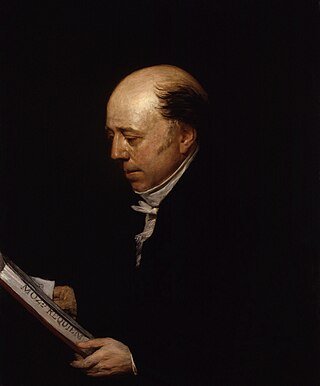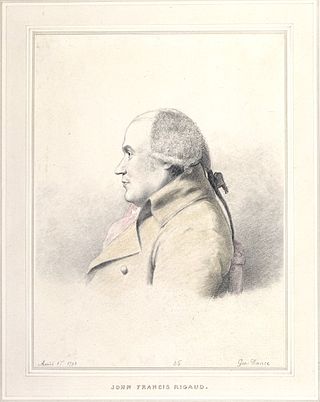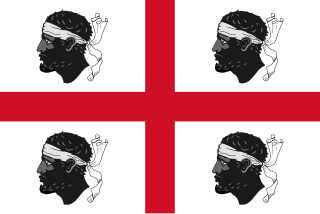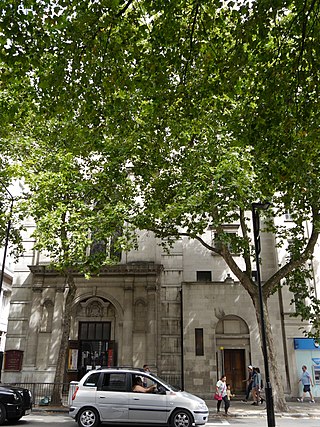The Sardinian Embassy Chapel was an important Catholic church and embassy chapel attached to the Embassy of the Kingdom of Sardinia in the Lincoln's Inn area of London. It was demolished in 1909.
The chapel was in existence several years before it became an embassy chapel. During the reign of James II, 54 Lincoln's Inn Fields was occupied by priests of the Franciscan Order, who built a chapel behind it. Following the flight of James II in 1688, the Franciscans withdrew and the chapel was destroyed by the mob. By 1700 the restored buildings were occupied by the Portuguese embassy, which probably moved into them soon after 1688. By 1715 a Sicilian embassy chapel is recorded there. In 1720 the Duke of Savoy exchanged his kingdom of Sicily with the Emperor for the kingdom of Sardinia. The first reference to the Sardinian chapel dates from 1722. [1] In 1759, the chapel burnt to the ground, but within three years a handsome and spacious new building was erected at the expense of the King of Sardinia. [2] The chapel was richly endowed with silver plate and works of art. The silver, which still belongs to the chapel's successor church, is now on loan and display at the Victoria and Albert Museum. [3]
A well-known print of London's eighteenth-century Catholic bishop, Richard Challoner shows him preaching in the Sardinian Chapel, behind him the chancel with its reredos painting of the Deposition. [1] Challoner called the Embassy Chapel "the chief support of religion in London," where it served as an "ersatz cathedral." [4]
Embassies were a very particular subset of clandestine churches. Early modern embassy staff, who commonly lived in the ambassadorial residence, were permitted to have in-house chapels and chaplains, especially where, in the wake of the Reformation, they lived in a country that banned their religious faith. These soon drew members of the same faith to join the worship services in the embassy. In London, the streets outside the houses and house chapels of the Spanish, French and Venetian embassies were the scenes of public protests, sometimes violent. The police sometimes attempted to detain British people who attended Catholic services in the embassy chapels, but embassy chapels were not exclusive to Britain or to Catholic embassies. The Dutch Republic sponsored chapels in twelve of its embassies, which acted as churches for local Reformed Protestants. Emperor Leopold I sponsored them wherever he could, "That Catholic services might be held to comfort the Catholics of the area, and to promote the further growth of this religion." [4] By the late eighteenth century, a new legal principle had come into being, extraterritoriality, according to which, "the ambassador and the precincts of the embassy stood as if on the soil of his homeland, subject only to its laws." [4] In the eighteenth century, English subjects ceased to be harassed for attending services at the Sardinian Embassy. On Easter Sunday 1772 James Boswell and Pasquale Paoli "worshipped together at the Sardinian Chapel." [5]
The chapel was again wrecked in the Gordon riots of 1780. Afterwards compensation was awarded by the government, and the chapel was repaired and reopened in 1781. In 1798, the Sardinian ambassador closed the chapel and proposed to let the house, but the chaplains and the Vicar Apostolic, Bishop John Douglass, were able to obtain the property. The embassy became a clergy house and the chapel was reopened in 1799. It continued, however, to be under the patronage and protection of the King of Sardinia until 1858. In 1853, the name of the chapel was altered to St Anselm's Church, which in 1861 was further altered to the Church of St Anselm and St Cecilia. [2]
When the thoroughfare of Kingsway was driven through the previous maze of tiny streets west of Lincoln's Inn Fields, the church was one of the many buildings that had to be demolished. An alternative site on which to build, fronting Kingsway, was provided. By disposal in 1902 of the old site opposite Keeley Street, Cardinal Vaughan was not only able to purchase the new site in Kingsway and erect upon it the present Church of St Anselm and St Cecilia, but he was left with some £10,000 to spare, which he placed to the credit of the Westminster Cathedral Building Fund. Several furnishings in the present church were brought from the old one, including the oval marble font with mahogany cover, the organ of 1857, the arms of the House of Savoy, the large painting of the Deposition, and in the south aisle the sarcophagus-shaped Lady Altar. [1] The former Sardinian Chapel was demolished in 1909, and replaced by the Church of St Anselm and St Cecilia. [2]

The Gordon Riots of 1780 were several days of rioting in London motivated by anti-Catholic sentiment. They began with a large and orderly protest against the Papists Act 1778, which was intended to reduce official discrimination against British Catholics enacted by the Popery Act 1698. Lord George Gordon, head of the Protestant Association, argued that the law would enable Catholics to join the British Army and plot treason. The protest led to widespread rioting and looting, including attacks on Newgate Prison and the Bank of England and was the most destructive in the history of London.

Vincent Novello, was an English musician and music publisher born in London. He was a chorister and organist, but he is best known for bringing to England many works now considered standards, and with his son he created a major music publishing house.

Richard Challoner was a leading figure of English Catholicism during the greater part of the 18th century, and the titular Bishop of Doberus. In 1738, he published a revision of the Douay–Rheims translation of the Bible.

Samuel Webbe was an English composer.

The Catholic Diocese of Westminster is an archdiocese of the Latin Church of the Catholic Church in England. The diocese consists of most of London north of the River Thames and west of the River Lea, the borough of Spelthorne, and the county of Hertfordshire, which lies immediately to London's north.
John Gother, also known as John Goter, was an English convert to Catholicism, priest, controvertist and eirenicist.

St Etheldreda's Church is a Roman Catholic church in Ely Place, off Charterhouse Street in Holborn, London. The building is one of only two surviving in London from the reign of Edward I, and dates from between 1250 and 1290. It is dedicated to Æthelthryth, or Etheldreda, the Anglo-Saxon saint who founded the monastery at Ely in 673. It was the chapel of the London residence of the Bishops of Ely.
James Robert Talbot was the last English Roman Catholic priest to be indicted in the public courts for saying Mass.

John Francis Rigaud was an eighteenth-century history, portrait, and decorative painter. Of French descent, he was born in Turin and spent most of his career in England.

The Sacheverell riots were a series of outbreaks of public disorder, which spread across England during the spring, summer and autumn of 1710 in which supporters of the Tories attacked the homes and meeting-houses of Dissenters, particularly those of Presbyterians, whose congregations tended to support the Whigs. The Sacheverell and Rebellion riots are regarded as the most serious instances of public disorder of the eighteenth century, until, perhaps, the anti-Catholic protests of 1780.

The Kingdom of Sardinia, also referred to as the Kingdom ofSardinia-Piedmont or Piedmont-Sardinia during the Savoyard period, was a state in Southern Europe from the late 13th until the mid 19th century.
George Pike England was an English organ builder who was among the most prominent in England during the late 18th and early 19th centuries.
Pacificus Baker, O.F.M. (1695–1774), was an English Minorite friar and noted Catholic spiritual writer of the 18th century.

St James' Church is a large English Gothic Catholic church in George Street, Marylebone, London. Although currently situated in George Street, the church maintains its connection with Spanish Place, the road opposite the current church, because of its historic connection with the Spanish Embassy. It is a Grade II* listed building.

The Church of Our Lady of the Assumption and St Gregory is a Catholic church on Warwick Street, Westminster. It was formerly known as the Royal Bavarian Chapel, because like several Catholic churches in London it originated as a chapel within a foreign embassy. It was built between 1789 and 1790 to the designs of Joseph Bonomi the Elder. The only surviving eighteenth-century Catholic chapel in London, it is a Grade II* listed building. The parish is now operated by the Personal Ordinariate of Our Lady of Walsingham, the British personal ordinariate for the Anglican Use within the Catholic Church.

The Church of St Anselm and St Cecilia is a Roman Catholic church at 310 Kingsway, Holborn, London.

Sardinia Street, formerly Duke Street was the northern continuation of Kemble Street. It ended, like its successor, on the west side (carriageway) of Lincoln's Inn Fields in the north, but further north. It was joined on its western side by King's Head Yard (demolished) and Wild Street, and opposite by Vere Street (demolished). On the eastern side at the northern end was a Roman Catholic chapel and chapel yard.

Sardinia Street is a short street in the City of Westminster and the London Borough of Camden that runs from Kingsway to the south-west corner of Lincoln's Inn Fields. It was named after the old Sardinia Street that was demolished during the construction of Kingsway in 1905.
An embassy chapel is a place of worship within a foreign mission. Historically they have sometimes acted as clandestine churches, tolerated by the authorities to operate discreetly. Since embassies are exempt from the host country's laws, a form of extraterritoriality, these chapels were able to provide services to prohibited and persecuted religious groups. For example, Catholic embassy chapels in Great Britain provided services while Catholicism was banned under the Penal Laws. A similar role was filled for Protestants by the Prussian embassy chapel in Rome, where Protestantism was unlawful until 1871. Upon laws granting freedom of religion, these embassy chapels have often become regularized churches and parishes, such as that of the Dutch embassy chapel to the Ottoman Empire, now The Union Church of Istanbul.